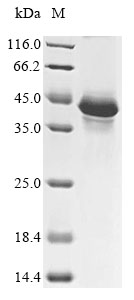The recombinant human FSHR protein is encoded by a recombinant DNA that was cloned into the expression vector and then transformed into the mammalian cells that support the expression of the gene. The recombinant DNA was constructed by fusing the N-terminal 6xHis tag gene to the gene fragment coding for the 18-366aa of the human FSHR protein. After purification, the product is the recombinant human FSHR protein. This recombinant FSHR protein was subjected to the SDS-PAGE determination. Its purity reaches over 85% evaluated by Bandscan software analysis combined with SAS-PAGE. This recombinant FSHR protein may have applications in neuroscience.
Researchers found the FSHR is related to the cyclic AMP-dependent protein kinases. In addition, FSHR could induce the extracellular signal-regulated kinases (ERK). FSHR play different roles in different tissues: in the ovary, FSHR expressed on the granulosa cells, it is essential for follicular development; for male, FSHR expression levels also have been identified on the Sertoli cells and it are necessary for spermatogenesis; in the secretory endometrium of uterus, FSHR expression was observed as well; more important, FSHR has been found to be selectively expressed in tumors.






